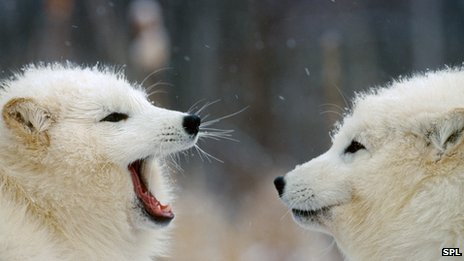Mercury exposure linked to dramatic decline in Arctic foxes
According to the research, the levels of mercury found in Arctic foxes depend on their diets Scientists say that foxes in Arctic regions who feed on ocean prey are being exposed to dangerous levels of mercury. On one Russian island where the population of foxes has crashed, the researchers believe the toxin has played a key role in the decline. They say the findings could have important implications for conservation. The data is published in the Journal, PLOS ONE. Mercury levels in the world's oceans have doubled over the past 100 years, according to the UN, with more mercury deposited in the Arctic than on any other part of the planet. The Arctic Council says there has been a ten-fold increase in the levels of mercury found in top predators in the region over the past 150 years. Hair of the dog Now a team of researchers says it has found significant levels of mercury in different populations of Arctic foxes in different environments. On the small Russian island of Mednyi, part of the Commander Islands chain in the North Pacific Ocean, the foxes survive almost exclusively on sea birds with some also eating seal carcasses. The island's fox population declined mysteriously in the 1970s, and while the population is currently stable many of them are in poor condition, and have low body weight. They are listed as a critically endangered species with IUCN. Scientists at one time believed their shrinking numbers were caused by an infection, but they couldn't find the underlying cause. "We started to look for different pathogens that might underline the cause of the poor condition and high mortality but we couldn't find anything," said Dr Gabor Czirjak from the Leibniz Institute for Zoo and Wildlife Research, a lead author on the new work. But when they examined hair samples from the foxes and the food the animals eat, they found significant rates of mercury. "They have high levels, compatible with the food, and it could explain the state of the foxes there," said Dr Czirjak. fox Arctic foxes change the colour of their fur depending on the season "We know it is in the marine environment and it is causing exactly the type of symptoms that were found in this population," he added. The team found a very different result when they compared the Russian foxes to their Icelandic cousins who live inland. These foxes survived on non-marine birds and rodents. They had much lower levels of the poison in their systems. The scientists say their findings have important lessons for conservation in the Arctic. "When you make a decision to try and conserve a species then you can make it based on the ecology or the feeding strategies that they use," said Dr Czirjak. "If we want to preserve the Arctic foxes, it is better to invest in the inland population where we can maintain or sustain in the long term, than in a coastal population where it is really hard to disconnect from the source which is the marine environment." The study raises some important questions about the how mercury is accumulating in the marine food chain in the Arctic region. Mercury levels there have for decades been linked to industrial pollution but recent research from Nasa has suggested that declining levels of sea ice in the region could be helping to push up levels of the substance. Global efforts to contain the poisonous effects of the element received a boost earlier this year when more than 140 countries agreed on a legally binding treaty to curb mercury pollution.






Recent comments